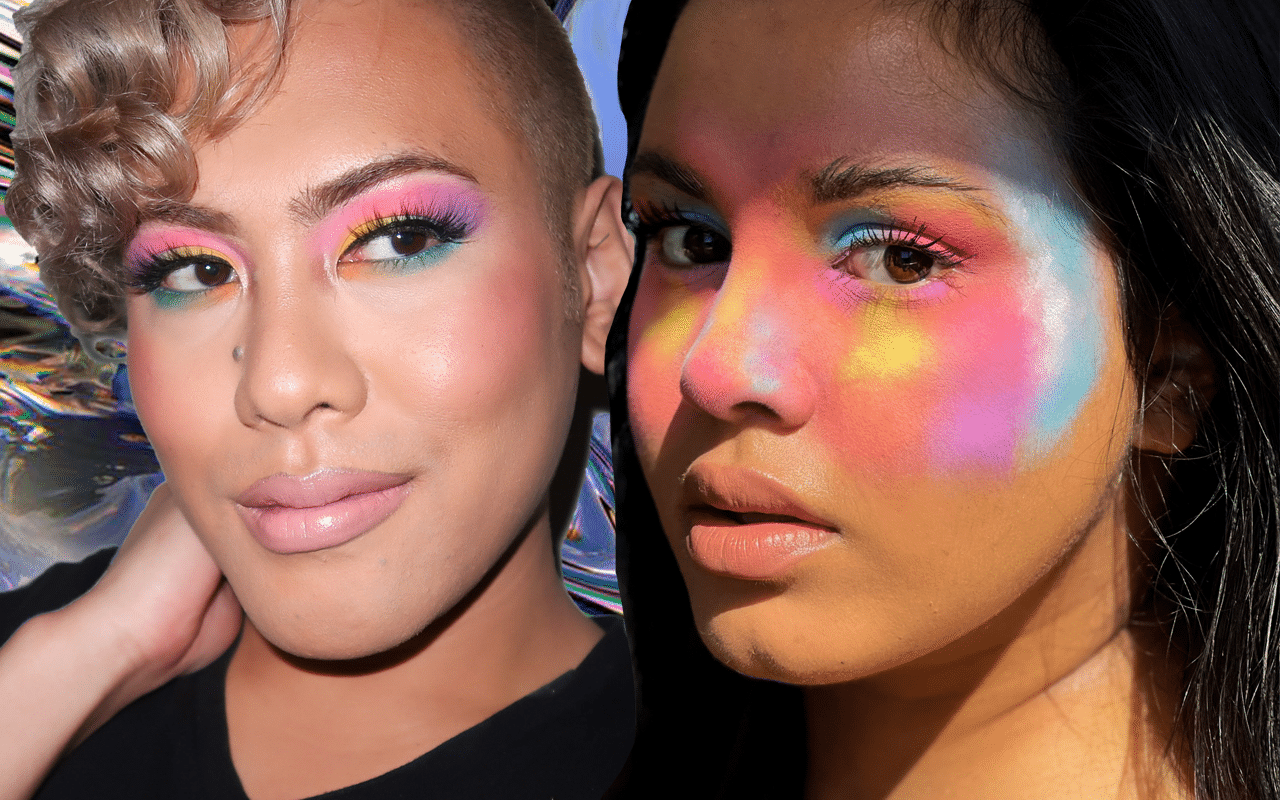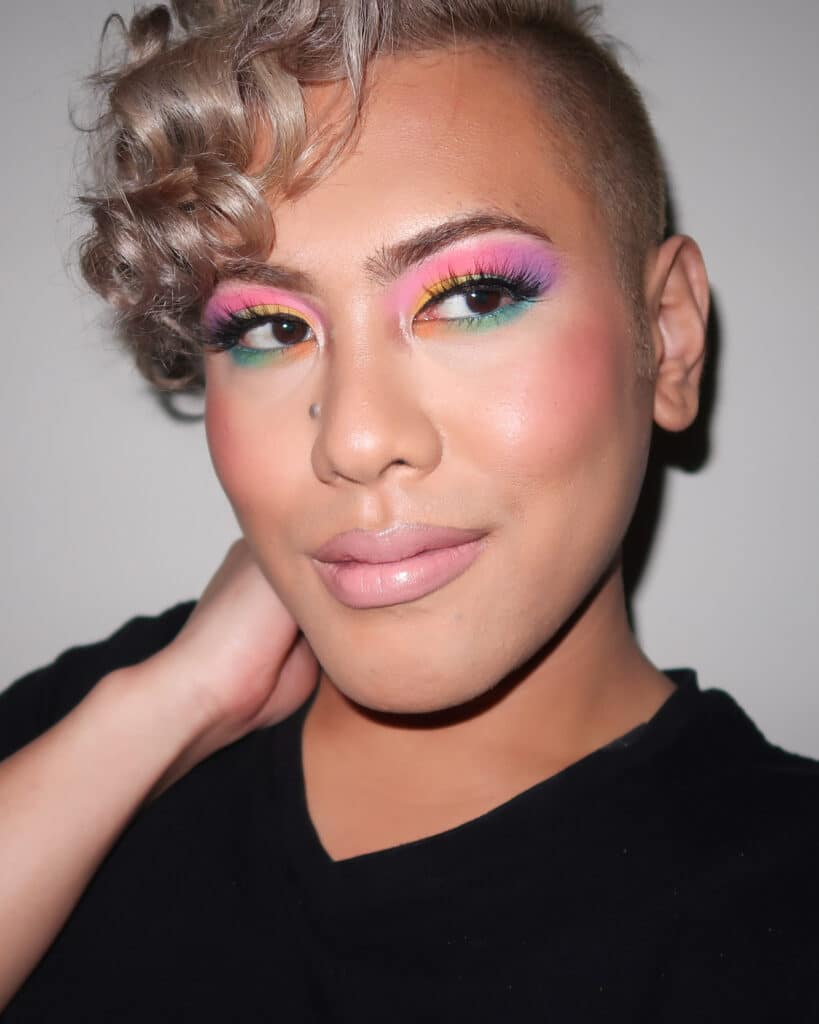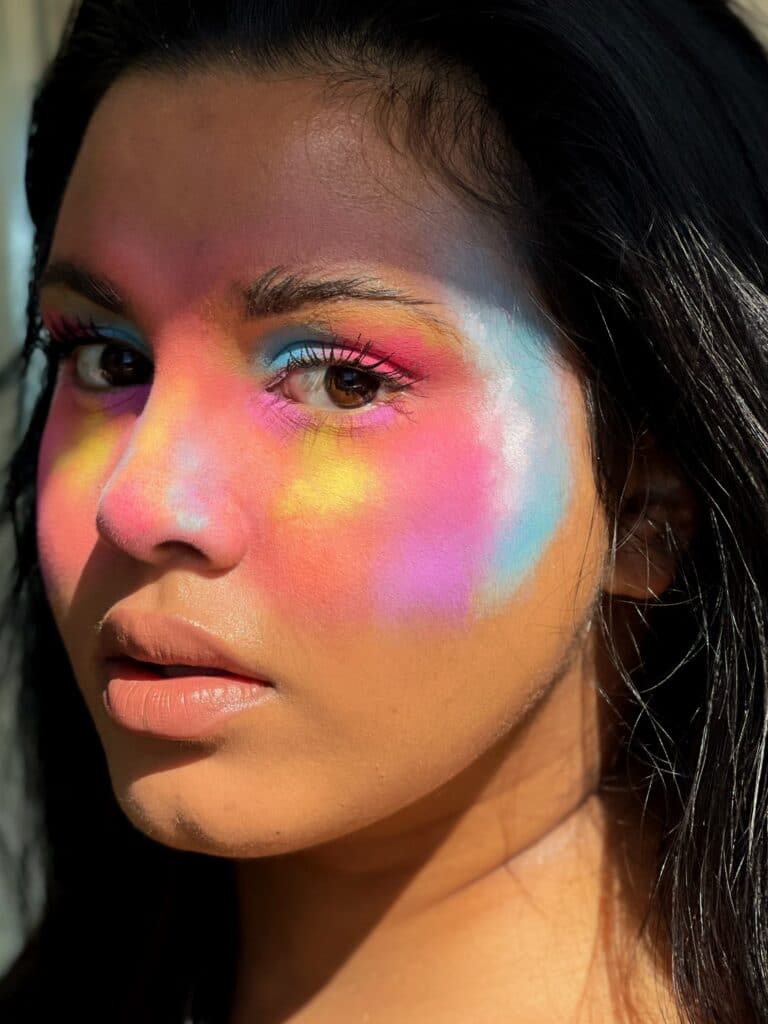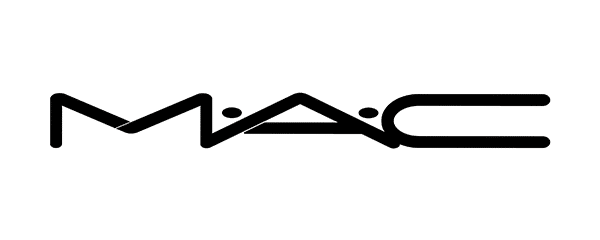
Faces of Australia is a column highlighting BIPOC creatives to bring you their stories. Creators are asked to collaborate on a makeup look that empowers, holds meaning, or describes their experience as it relates to Australian beauty standards and the Australian beauty industry. Faces of Australia is written and produced by Ruchi Page, with a mission to show the beauty industry how accessible BIPOC talent is across this diverse nation.
This second episode of my series explores what happens when you celebrate all the shades of the rainbow— a colour explosion. Introducing makeup artist and social media influencer, Ken Valdejueza. Our collaborative, vibrant makeup look is intentional. It draws on the liberation we have created for ourselves as members of the BIPOC community; representing the final result of defeating racial stereotypes and discrimination. To perfect the look, we used M.A.C Cosmetics Studio Fix Fluid Foundation as the base point for this artistry. This glamour is a celebratory visual of our identity.
Born and raised in Hong Kong, Ken tells me he is a “proud, gay Asian man”. With his father’s side being Spanish and Filipino and his mother’s side Chinese, Filipino, and possibly Indian, Ken confirms his ethnic background is definitely diverse. The registered cosmetic nurse and multifaceted creator has been on my radar for some time.
With 10 years of experience as a blogger, YouTuber, and social media influencer, Ken is certainly deserving of OG status. Recently, I noticed Ken has been using his platforms to share the challenges he’s faced regarding culture claiming and stereotypes. His content immediately resonated with my own lived experiences, so I reached out to Ken to hear his story.
Following the discussion about his background, I asked Ken how he identifies when it comes to his ethnicity. “Being mixed race is pretty common in the Philippines,” he tells me. “I normally just answer I am ethnically Filipino whenever asked, as it’s easier that way. I feel if I say I am mixed race, I usually get criticised for ‘claiming’ to be part of this and that.”

Interestingly, I could relate to this. It seems to be ‘important’ or ‘necessary’ to fit a specific stereotype or mould when it comes to identifying as multiple ethnicities. We both agreed that people of colour feel pressure to act like, or visually uphold, certain stereotypes based on our ethnicity. Ken is an example of breaking out of this box. “Culturally, despite growing up in a Filipino household, I don’t subscribe to many of the traditional Filipino values, as I went to an international school and felt more comfortable with Western values,” he explains. I asked Ken why he felt more comfortable with the Western lifestyle. “Growing up being a ‘darker’ child and being gay made me feel like an outsider to my Filipino community back in Hong Kong,” he says. “So I looked elsewhere.”
A big reason I wanted to speak to Ken was because of a conversation he raised with his followers around racial categorising— a conversation inspired by years of being told to act like a ‘normal Asian’ and to stop ‘white-washing.’ We both noted that this experience is incredibly dehumanising and othering. I asked Ken how these comments have contributed to his daily life. “I personally do not get affected by these comments anymore. I believe people that make comments like these are not very open-minded, nor do they see the world how it truly is in this day and age and to be honest, are racist to some level,” he tells me.
Ken highlights that “as an immigrant, I have always been advised to try your best to assimilate and I have, but then I get comments such as these. I get told I am not Asian enough from my fellow Asians and that I am white-washed from others. You cannot win and honestly, I do not care at this point,” he says. “I am living my best life and that is all that matters.”
Inspired is an understatement. I understood Ken’s comment to be a true testament to his own solidified identity; regardless of opinion, Ken stands tall with pride in his ethnicity and his determination for equality in Australia.
As our conversation veered to an end, I wanted to gauge the creator’s experience when it comes to belonging to the ‘Australian checklist’. To put it into perspective, nearly every small talk encounter I have experienced with a stranger results in confusion; my Australian accent and brown skin apparently means that I cannot be an authentic Aussie, right?
Similarly, Ken’s British accent has caused frustration in new conversations, where strangers cannot seem to place the ‘correct’ nationality. I asked Ken if over explaining the “why I’m here” narrative has been as much of an issue for him as it has been for me. “One memory that comes to mind is when this guy came up to me at a party,” he recalls. “He was having a general chat with me but then became dumbfounded by my accent. I asked if anything was the matter and he responded that my voice shouldn’t be coming out of my mouth. I was honestly confused by his statement and asked him to clarify. He said that he was amazed at how I didn’t have a trace of an Asian accent and that Asian people usually have an accent.”

Shocked but not surprised, I could somewhat relate to the ton of these comments. There tends to be an element of shock value when it comes to the BIPOC community not fitting into one certain box, as though we need to follow a manual in order to provide comfort for others. Both Ken and I wish to remind those reading this that there is always a polite way to ask questions when it comes to ethnicity and origins. “In terms of asking about my background, I feel people confuse nationality and ethnicity all the time,” Ken explains. “I always get asked, ‘what is your nationality?’ to which I respond, ‘Australian’ (as I am a citizen now). This is usually followed by questions along the lines of, ‘but where are you originally from?’ I then respond with ‘Hong Kong,’ and then they reply, ‘oh, but you don’t look Chinese.’ I then explain my ethnicity. People can get a bit nasty when I reply in this manner. I don’t mind being asked but I would prefer if they used the right terminology to avoid confusion.”
Despite Ken’s experiences and lack of representation within the beauty space, he is proud of his identity. When asked about seeing himself in the beauty space, the influencer was unable to collect pivotal moments where he could relate to the beauty world. Ken says that “it has only been in the last few years that every now and then a masculine-presenting person wearing makeup will be in an ad/campaign”. Additionally, he notes that tokenism with Asian beauty is alive and well, so identifying with the beauty industry in Australia has been a struggle.
I ended our chat by asking Ken the one question I ask all my interviewees: What advice can you offer the Australian beauty industry? This is what he tells me:
“The industry has made huge improvements over the last few years but I definitely feel there is room for more, especially in the way of diversity. In all aspects of the word. I believe there should be more representation of all types of people. I also would recommend brands do more research into consumers and the customers they are missing out on. I feel most just forget about BIPOC and just assume they won’t buy their base products so they just offer the lighter shades.”
Faces of Australia season 2 is brought to you by








